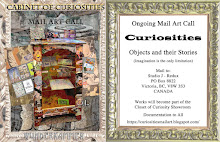




The recent gathering of Victoria artists at "Studio J" who recieved one of the shoes and the visual response to the call.
This was my first attempt at needle felting . . now I'm "hooked"
More on Stella's project below:
--------------------------------------------------
a response to the exhibition by Heidi Eigenkind
In footnote, Stella Meades pays homage to the circumstances of her own childhood and to those children still affected by war and ethnic hatreds.1 Taking as her starting point, a 1995 UNICEF statistic that 6,000,000 children have been disabled or killed in the last decade, Meades handbuilt 1001 shoes. Each one of the first 1000 represents 6000 injured or dead children. The extra shoe moves the installation beyond the statistic’s timeline, into the present and the future.
By bolding the second half of the exhibition’s title, Meades asks that we take notice, that we take account of these shoes/lives, that we count them in. If we consent, it is because of the close fit between these objects and their maker’s objective. Clay here is a felicitous medium. In Meades’ hands, it imitates various materials - most often leather and always, the vulnerability of skin. There is a strong cultural identification between shoes and those who wear them evidenced, as Meades points out, in the phrase “walk a mile in my shoes”.2 And children’s shoes, bronzed and mounted, have functioned for decades as treasures North American family icons, sentimental embodiments of innocence and safety.

Meades’ 1001 shoes evoke other qualities and circumstances. She has shaped the installation into an elongated mound, a groin against the erosion of memory, the pull of denial’s tides. And though she has not anchored it to a specific time, the work is not completely timeless. Since 1945, any collection of sorted objects carries the echoes of Nazi warehouses stuffed with personal belongings confiscated from camp arrivals by the henchmen of Hitler’s ‘Final Solution’. This historical reverberation links footnote to Meades’ childhood experiences in Britain during the Second World War. Some of the shoes, the Buster Browns and Mary Janes, suggest the 1950’s and 60’s. One of my friends commented on the lack of current children’s footwear - hightops for toddlers, and the rubber tire and plastic shoes commonly worn in ‘developing’ countries. When I asked Meades about this absence, she explained that although she had wanted the shoes to be mainly neutral in terms of style, she had tried to make footwear suited to the decade covered by the UNICEF statistic. Her inclusion of sneakers and thongs are meant to provide a more contemporary and possibly less culturally specific presence. Given the nearly inescapable influence of fashion on what North Americans and Europeans wear, such neutrality may be only partially achievable. And I do not think it is essential to this installation’s impact.
It is common knowledge that numbers numb. In footnote, Meades offers us intimate contact with a reality that unmediated could easily overwhelm us. Six million is a Holocaust number, one too large to comprehend in individual human terms. In contrast, Meades’ 1001 shoes constitute a visually and emotionally understandable accounting of 6,000,000 children’s fates. She presents us with an experience we can grasp at a glance or explore in detail. Her marking of the shoes - the bullet holes, wire wrappings, low fire charrings, the tire treads and squashing- read as desecrations carried out on children’s flesh. The shoes speak softly and unflinchingly. And amongst all the scarrings, the hurt surfaces, Meades has drawn occasional stick figures, her signature and evidence of hope.
footnote owes much of its strength to Meades’ ability to combine intense feelings with simplicity of approach. Her installation has no graphic elements, no dramatic splatters of blood. For one year, Meades worked to create a subtle and potent memorial to those who, in her words, historically have been “shuffled off” or declared minor annotations to war’s greater meanings. She has made children and what they needlessly suffer the primary text. The result is a space made sacred by the presences of the young selves Meades has honoured through her art. I don’t know if the timing of this show, which ended just before Remembrance Day, was coincidental. If so, I am grateful to both chance and Meades for helping me remember the millions of poppets hurt and killed in war, when on downtown street corners those selling red felt poppies insist on commemorating only the wounding and death of ‘bonified’ uniformed, adult male victims.
NOTES
1. A reworking of the artist’s statement accompanying the exhibition
2. From a conversation with the artist
Heidi Eigenkind is an artist and writer once again living in Winnipeg.








No comments:
Post a Comment